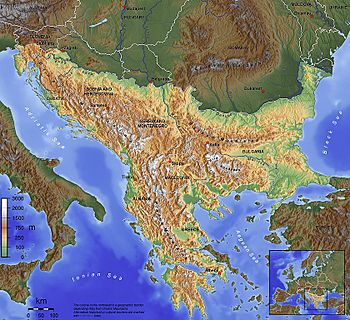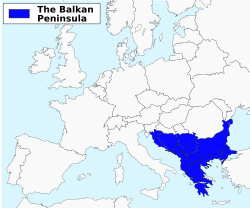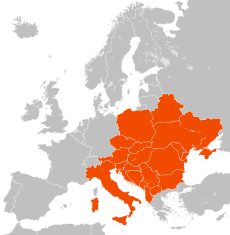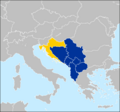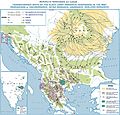Balkans facts for kids
The Balkans is a peninsula in Europe. The region has a combined area of 550,000 km² and an approximate population of 55 million people. The region takes its name from the Balkan Mountains, which run through the centre of Bulgaria into eastern Serbia and then continue to Slovenia as the Dinaric Alps.
Contents
Definitions and boundaries
Name
Balkans comes from the Turkish language meaning “chain of wooded mountains” or 'swampy forest'.
Geography
The Balkans are bordered by water on three sides: the Black Sea to the east and branches of the Mediterranean Sea to the south and west (including the Adriatic, Ionian, Aegean and Marmara seas). The Balkan Peninsula is bordered on the north by the Danube, Sava, and Krča rivers.
Member countries
Countries in the Balkan region are:
- Albania
- Kosovo
- Bosnia and Herzegovina
- Bulgaria
- Croatia
- Greece
- Montenegro
- North Macedonia
- Romania (sometimes)
- Serbia
- Slovenia (sometimes)
- Turkey (sometimes)
Related countries
Other countries that are not in the Balkan region but that are close to it and/or play or have played an important role in the region's politics, culture and history:
- Austria (see also Austria-Hungary, Assassination of Archduke Franz Ferdinand of Austria)
- Cyprus (see also Cyprus dispute)
- Hungary (see also Austria-Hungary)
- Italy (see Trieste and History of the Republic of Venice)
- Russia (see History of Serbia)
Population composition by nationality and religion
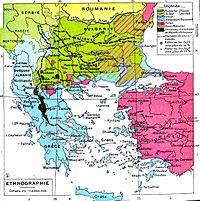
The region's principal nationalities include:
- Albanians (5 million)
- Bosniaks (4.5 million)
- Bulgarians (6.6 million)
- Croats (4.5 million)
- Greeks (10.7 million)
- Macedonians (1.3 million)
- Montenegrins (0.3 million)
- Romanians (22 million)
- Serbs (8 million)
- Slovenes (2 million)
- Turks (80 million)
- others (Roma, Gorani, Hungarians, Czechs ...)
The most common religions in the Balkans are Eastern Orthodox and Catholic Christianity and Islam (mostly Sunni or non-denominational). Many different specific kinds of each faith are practiced, with each of the Eastern Orthodox countries having its own national church with its own patriarch.

Eastern Orthodoxy is the principal religion in the following countries:
- Bulgaria (Bulgarian Orthodox Church)
- Greece (Greek Orthodox Church)
- Montenegro (Serbian Orthodox Church or uncanonical Montenegrin Orthodox Church)
- North Macedonia (Serbian Orthodox Church or uncanonical Macedonian Orthodox Church)
- Romania (Romanian Orthodox Church)
- Serbia (Serbian Orthodox Church)
Roman Catholicism is the principal religion in the following countries:
- Croatia
- Slovenia
Islam is the principal religion in the following countries:
- Albania
- Turkey
Bosnia and Herzegovina is a special case - 50% are Muslim Bosniaks, 31% are Serbian Orthodox, and 15% are Catholic Croats (therefore 46% are Christian). The remaining 4% adhere to other denominations of Christianity, other religions, or are irreligious.
For more detailed information and a precise ethnic breakdown see articles about particular states:
- Albania (Demographics of Albania)
- Croatia (Demographics of Croatia)
- Bosnia and Herzegovina (Demographics of Bosnia and Herzegovina)
- Bulgaria (Demographics of Bulgaria)
- Greece (Demographics of Greece)
- Montenegro (Demographics of Montenegro)
- North Macedonia (Demographics of North Macedonia)
- Turkey (Demographics of Turkey)
- Banac, Ivo. Historiography of the Countries of Eastern Europe: Yugoslavia, American Historical Review, v 97 #4 (October 1992), 1084-1104.
- Banac, Ivo. The National Question in Yugoslavia: Origins, History, Politics Cornell University Press, [1984].
- Carter, Francis W., ed. An Historical Geography of the Balkans Academic Press, 1977.
- Dvornik, Francis. The Slavs in European History and Civilization Rutgers University Press, 1962.
- Fine, John V. A., Jr. The Early Medieval Balkans: A Critical Survey from the Sixth to the Late Twelfth Century [1983]; The Late Medieval Balkans: A Critical Survey from the Late Twelfth Century to the Ottoman Conquest. Ann Arbor: University of Michigan Press, [1987].
- John R. Lampe and Marvin R. Jackson; Balkan Economic History, 1550-1950: From Imperial Borderlands to Developing Nations Indiana University Press, 1982
- Jelavich, Barbara. History of the Balkans, 2 vols. Cambridge University Press, [1983].
- Jelavich, Charles, and Jelavich, Barbara, eds. The Balkans in Transition: Essays on the Development of Balkan Life and Politics since the Eighteenth Century University of California Press, 1963.
- Király, Béla K., ed. East Central European Society in the Era of Revolutions, 1775-1856. 1984
- Komlos, John, ed. Economic Development in the Habsburg Monarchy and in the Successor States: Essays 1990.
- Mazower, Mark, The Balkans: A Short History, 2000
- Traian Stoianovich; Balkan Worlds: The First and Last Europe 1994.
Images for kids
-
Western Balkan countries – Albania, Bosnia and Herzegovina, Croatia, Kosovo, Montenegro, North Macedonia, and Serbia. Croatia (yellow) joined the EU in 2013.
-
Panorama of the Balkan Mountains (Stara Planina). Its highest peak is Botev at a height of 2,376 m.
-
Sutjeska National Park contains Perućica, which is the largest primeval forests in the Balkans, and one of the last remaining in Europe.
-
Lake Skadar is the largest lake in the Balkans and Southern Europe.
-
Remnants of the Felix Romuliana Imperial Palace, a UNESCO World Heritage Site
-
Apollonia ruins near Fier, Albania
-
Hagia Sophia, built in sixth century Constantinople (now Istanbul, Turkey) as an Eastern Orthodox cathedral, later a mosque, then a museum, and now both a mosque and a museum
-
The 13th-century Church of St. John at Kaneo and the Ohrid Lake in North Macedonia. The lake and town were declared a World Heritage Site by UNESCO in 1980.
-
State entities on the former territory of Yugoslavia, 2008
-
Approximate distribution of religions in Albania
-
Transhumance ways of the Romance-speaking Vlach shepherds in the past
See also
 In Spanish: Península balcánica para niños
In Spanish: Península balcánica para niños


